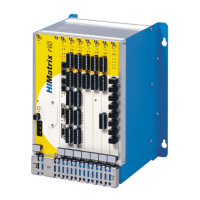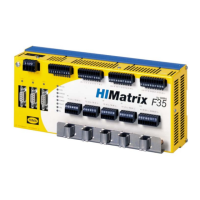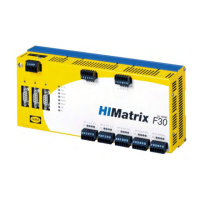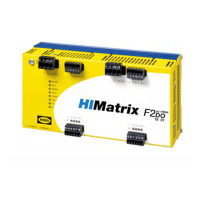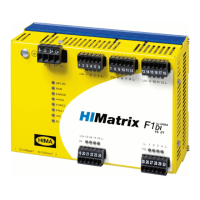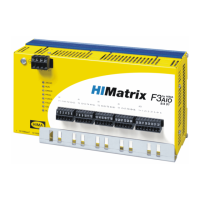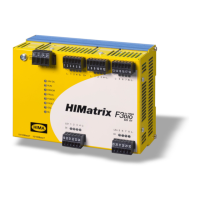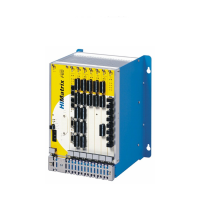Do you have a question about the HIMA HIMatrix F60 and is the answer not in the manual?
Overview of the manual's chapters and guidance on how to use it effectively.
Identifies the intended readers and required specialized knowledge for this manual.
Explains document formatting, including font usage, symbols, and cross-references.
Information on HIMA's training programs, service department, and contact details.
Defines permitted applications and conditions for safe use of HIMatrix systems.
Specifies climatic, mechanical, and EMC conditions required for system operation.
Outlines safety responsibilities for operators and manufacturers.
Details essential measures to prevent electrostatic discharge damage during handling.
Identifies potential risks that may remain after safety measures are applied.
Emphasizes observing local safety requirements and using protective equipment.
Describes system behavior during emergencies and necessary safety actions.
Describes the modular structure of the HIMatrix F60 system and its components.
Explains system supply voltage monitoring capabilities and operational requirements.
Details system temperature monitoring and associated states.
Describes system reaction to short-circuits on output channels.
Explains system capability to record alarms and sequences of events (SOE).
Provides key specifications and technical data for the HIMatrix F60 system.
Explains licensing requirements for activating specific controller features.
Lists and describes communication protocols supported by HIMatrix systems.
Covers Ethernet communication, including safeethernet and other protocols.
Details configuration and use of fieldbus interfaces and submodules.
Outlines fundamental functions of the controller's operating system.
Explains how to view and identify installed operating system versions.
Describes system reaction to different types of faults and errors.
Details central processor system, monitoring functions, and modes of operation.
Explains different modes for running and testing the user program.
Describes program cycle and multitasking capabilities of CPU 03.
Details process of reloading modified user programs during operation.
Explains concept and purpose of forcing variables in user programs.
Covers global and local forcing methods for CPU OS V7 and higher.
Explains forcing parameters and configuration for CPU OS up to V7.
Discusses heat dissipation and its importance for system lifetime.
Provides detailed instructions for physical installation and mounting of the system.
Guides configuration process using SILworX for specific OS versions.
Explains how to set up and manage user access for SILworX projects and controllers.
Details configuring communication interfaces using SILworX for V7 OS and higher.
Describes process of configuring alarms and events for CPU 03.
Guides configuration process using ELOP II Factory for older OS versions.
Details configuring communication interfaces using ELOP II Factory for older OS versions.
Covers basic handling and operational aspects of the controller.
Explains how to diagnose controller status using LEDs and diagnostic history logs.
Discusses common interferences, indicators, and basic troubleshooting steps.
Provides recommendations and intervals for regular replacement of system fans.
Details procedure for loading new operating systems onto the controller.
States that operators are not authorized to repair devices and modules.
Provides definitions for technical terms used throughout the manual.
Lists all figures within the document with their corresponding page numbers.
Lists all tables within the document with their corresponding page numbers.
Overview of the manual's chapters and guidance on how to use it effectively.
Identifies the intended readers and required specialized knowledge for this manual.
Explains document formatting, including font usage, symbols, and cross-references.
Information on HIMA's training programs, service department, and contact details.
Defines permitted applications and conditions for safe use of HIMatrix systems.
Specifies climatic, mechanical, and EMC conditions required for system operation.
Outlines safety responsibilities for operators and manufacturers.
Details essential measures to prevent electrostatic discharge damage during handling.
Identifies potential risks that may remain after safety measures are applied.
Emphasizes observing local safety requirements and using protective equipment.
Describes system behavior during emergencies and necessary safety actions.
Describes the modular structure of the HIMatrix F60 system and its components.
Explains system supply voltage monitoring capabilities and operational requirements.
Details system temperature monitoring and associated states.
Describes system reaction to short-circuits on output channels.
Explains system capability to record alarms and sequences of events (SOE).
Provides key specifications and technical data for the HIMatrix F60 system.
Explains licensing requirements for activating specific controller features.
Lists and describes communication protocols supported by HIMatrix systems.
Covers Ethernet communication, including safeethernet and other protocols.
Details configuration and use of fieldbus interfaces and submodules.
Outlines fundamental functions of the controller's operating system.
Explains how to view and identify installed operating system versions.
Describes system reaction to different types of faults and errors.
Details central processor system, monitoring functions, and modes of operation.
Explains different modes for running and testing the user program.
Describes program cycle and multitasking capabilities of CPU 03.
Details process of reloading modified user programs during operation.
Explains concept and purpose of forcing variables in user programs.
Covers global and local forcing methods for CPU OS V7 and higher.
Explains forcing parameters and configuration for CPU OS up to V7.
Discusses heat dissipation and its importance for system lifetime.
Provides detailed instructions for physical installation and mounting of the system.
Guides configuration process using SILworX for specific OS versions.
Explains how to set up and manage user access for SILworX projects and controllers.
Details configuring communication interfaces using SILworX for V7 OS and higher.
Describes process of configuring alarms and events for CPU 03.
Guides configuration process using ELOP II Factory for older OS versions.
Details configuring communication interfaces using ELOP II Factory for older OS versions.
Covers basic handling and operational aspects of the controller.
Explains how to diagnose controller status using LEDs and diagnostic history logs.
Discusses common interferences, indicators, and basic troubleshooting steps.
Provides recommendations and intervals for regular replacement of system fans.
Details procedure for loading new operating systems onto the controller.
States that operators are not authorized to repair devices and modules.
Provides definitions for technical terms used throughout the manual.
Lists all figures within the document with their corresponding page numbers.
Lists all tables within the document with their corresponding page numbers.
| Model | HIMatrix F60 |
|---|---|
| Category | Controller |
| Type | Safety Controller |
| Input Voltage | 24 V DC |
| Safety Integrity Level (SIL) | SIL 3 |
| Performance Level (PL) | PLe |
| Memory | 512 MB RAM |
| Communication Protocols/Interfaces | Ethernet |
| Number of Inputs | Configurable, depends on I/O modules |
| Number of Outputs | Configurable, depends on I/O modules |
| Safety Standard | IEC 61508 |
| Certifications | TÜV |
